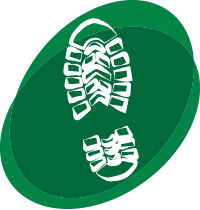We propose a novel method to quantify the similarity between an impression (Q) from an unknown source and a test impression (K) from a known source. Using the property of geometrical congruence in the impressions, the degree of correspondence is quantified using ideas from graph theory and maximum clique (MC). The algorithm uses the x and y coordinates of the edges in the images as the data. We focus on local areas in Q and the corresponding regions in K and extract features for comparison. Using pairs of images with known origin, we train a random forest to classify pairs into mates and non-mates. We collected impressions from 60 pairs of shoes of the same brand and model, worn over six months. Using a different set of very similar shoes, we evaluated the performance of the algorithm in terms of the accuracy with which it correctly classified images into source classes. Using classification error rates and ROC curves, we compare the proposed method to other algorithms in the literature and show that for these data, our method shows good classification performance relative to other methods. The algorithm can be implemented with the R package shoeprintr.
Quantifying the similarity of 2D images using edge pixels: An application to the forensic comparison of footwear impressions

Journal: Journal of Applied Statistics
Published: 2020
Primary Author: Soyoung Park
Secondary Authors: Alicia Carriquiry
Type: Publication
Research Area: Footwear
Related Resources
Shoeprint Alignment and Comparison using Maximum Cliques
This presentation is from the 107th International Association for Identification (IAI) Annual Educational Conference, National Harbor, Maryland, August 20-26, 2023. Posted with permission of CSAFE.
An algorithm for source identification of footwear impressions—its application on pristine shoeprints and crime-scene like shoeprints
This presentation is from the 107th International Association for Identification (IAI) Annual Educational Conference, National Harbor, Maryland, August 20-26, 2023. Posted with permission of CSAFE.
CSAFE Project Update & ASCLD FRC Collaboration
This presentation highlighted CSAFE’s collaboration with the ASCLD FRC Collaboration Hub.
Source identification of shoeprints in mock crime scene using an algorithm based on automatic alignment
This presentation is from the 75th Anniversary Conference of the American Academy of Forensic Sciences, Orlando, Florida, February 13-18, 2023. Posted with permission of CSAFE


